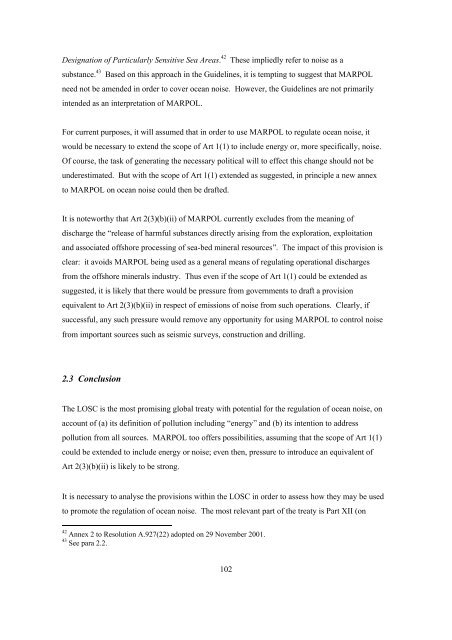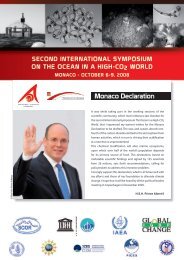Oceans of noise - Whale and Dolphin Conservation Society
Oceans of noise - Whale and Dolphin Conservation Society
Oceans of noise - Whale and Dolphin Conservation Society
- No tags were found...
You also want an ePaper? Increase the reach of your titles
YUMPU automatically turns print PDFs into web optimized ePapers that Google loves.
Designation <strong>of</strong> Particularly Sensitive Sea Areas. 42 These impliedly refer to <strong>noise</strong> as asubstance. 43 Based on this approach in the Guidelines, it is tempting to suggest that MARPOLneed not be amended in order to cover ocean <strong>noise</strong>. However, the Guidelines are not primarilyintended as an interpretation <strong>of</strong> MARPOL.For current purposes, it will assumed that in order to use MARPOL to regulate ocean <strong>noise</strong>, itwould be necessary to extend the scope <strong>of</strong> Art 1(1) to include energy or, more specifically, <strong>noise</strong>.Of course, the task <strong>of</strong> generating the necessary political will to effect this change should not beunderestimated. But with the scope <strong>of</strong> Art 1(1) extended as suggested, in principle a new annexto MARPOL on ocean <strong>noise</strong> could then be drafted.It is noteworthy that Art 2(3)(b)(ii) <strong>of</strong> MARPOL currently excludes from the meaning <strong>of</strong>discharge the “release <strong>of</strong> harmful substances directly arising from the exploration, exploitation<strong>and</strong> associated <strong>of</strong>fshore processing <strong>of</strong> sea-bed mineral resources”. The impact <strong>of</strong> this provision isclear: it avoids MARPOL being used as a general means <strong>of</strong> regulating operational dischargesfrom the <strong>of</strong>fshore minerals industry. Thus even if the scope <strong>of</strong> Art 1(1) could be extended assuggested, it is likely that there would be pressure from governments to draft a provisionequivalent to Art 2(3)(b)(ii) in respect <strong>of</strong> emissions <strong>of</strong> <strong>noise</strong> from such operations. Clearly, ifsuccessful, any such pressure would remove any opportunity for using MARPOL to control <strong>noise</strong>from important sources such as seismic surveys, construction <strong>and</strong> drilling.2.3 ConclusionThe LOSC is the most promising global treaty with potential for the regulation <strong>of</strong> ocean <strong>noise</strong>, onaccount <strong>of</strong> (a) its definition <strong>of</strong> pollution including “energy” <strong>and</strong> (b) its intention to addresspollution from all sources. MARPOL too <strong>of</strong>fers possibilities, assuming that the scope <strong>of</strong> Art 1(1)could be extended to include energy or <strong>noise</strong>; even then, pressure to introduce an equivalent <strong>of</strong>Art 2(3)(b)(ii) is likely to be strong.It is necessary to analyse the provisions within the LOSC in order to assess how they may be usedto promote the regulation <strong>of</strong> ocean <strong>noise</strong>. The most relevant part <strong>of</strong> the treaty is Part XII (on42 Annex 2 to Resolution A.927(22) adopted on 29 November 2001.43 See para 2.2.102




